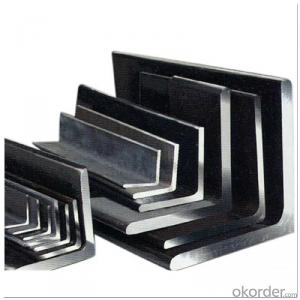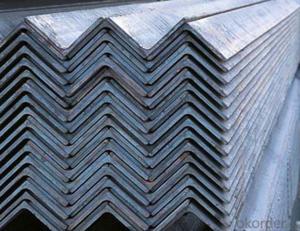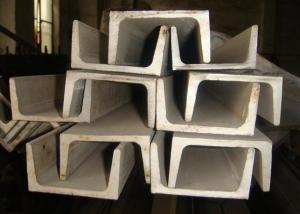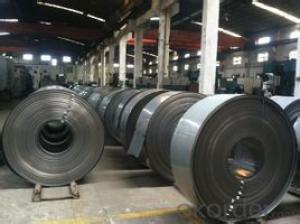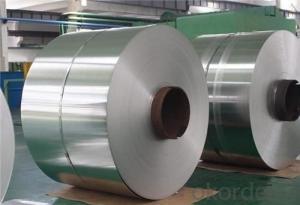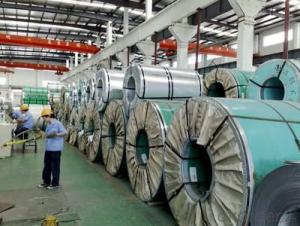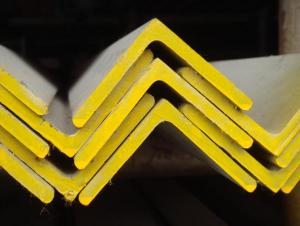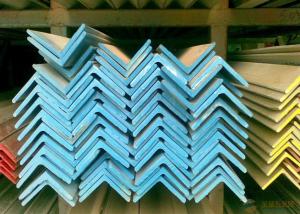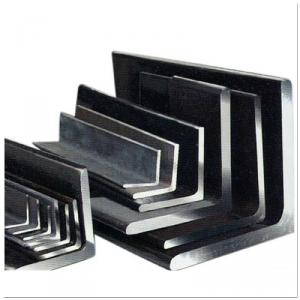stainless angles steel aisi 304 in L shaped
- Loading Port:
- Qingdao
- Payment Terms:
- TT OR LC
- Min Order Qty:
- 10 m.t.
- Supply Capability:
- 5000 m.t./month
OKorder Service Pledge
OKorder Financial Service
You Might Also Like
Products Information
Standard | AISI, ASTM, BS, DIN, GB, JIS, etc |
Grade | Q195, Q215, Q235, Q345, SS400, A36, S235JR, ST37, etc |
Technical parameters:
1) Material: Q235B , Q 345B, SS400 ,SS540, S235JR ,ETC. | |||
| 2) Usage: structure construction and electronic tower building | |||
| 3) Weight tolarance: -4% TO -10% | |||
| 4) Size tolarance : | |||
| ANGLE STEEL SIstructural steel angleE TOLARANCE (MM) | |||
| SIstructural steel angleE cm | WIDTH b/mm | THICKNESS d/mm | LENGTH /m |
| 2-5.6 | +/-0.8 | +/-0.4 | 4-12 |
| 6.3-9 | +/-1.2 | +/-0.6 | 4-12 |
| 10-14 | +/-1.8 | +/-0.7 | 4-12 |
| 16-20 | +/-2.5 | +/-1.0 | 4-12 |
| 5) Payment terms: TT or LC | |||
| 6) Delivery date: within 30 days after receiving the LC or TT prepay | |||
| 7) Packing: Export package | |||
| 8) Inspection: accept third party inspection | |||
Added information
| ||
Standard | ASTM A276, A484, A479, A580, A582, JIS G4303, JIS G4311, DIN 1654-5,DIN 17440,GB/T 1220 | |
Material | 200,300,400series, 201,202,301,304,304L,309S,310S,316,316L,316Ti,317,317L,321,347H,410,420,430,etc | |
Type | Round,square,hexagonal,flat,angle | |
Surface | Pickled,Black,Bright,Polishing,Blasting,etc | |
Specifications | Round bar | Diameter: 3mm~800mm |
Angle bar | Size: 3mm*20mm*20mm~12mm*100mm*100mm | |
Square bar | Size: 4mm*4mm~100mm*100mm | |
Flat bar | Thickness: 2mm~100mm | |
Width: 10mm~500mm | ||
Hexagonal | Size: 2mm~100mm | |
Length | 6m,5.8m,12m or as required | |
Price Term | FOB, CFR, CIF,CNF | |
Payment Term | T/T,L/C, | |
Minimum order quantity | 10 Ton | |
Package | Bundled,wooden box for export standard package. Export standard package, bundled or be required. The inner size of container is below: 20ft GP: 5.9m(length) x 2.13m(width) x 2.18m(high) about 24-26CBM 40ft GP: 11.8m(length) x 2.13m(width) x 2.18m(high) about 54CBM 40ft HG: 11.8m(length) x 2.13m(width) x 2.72m(high) about 68CBM | |
Delivery Time | Normally according to the order quantity | |
Application | Stainless steel bar applies to petroleum, chemical industry,electric power, boiler, high temperature resistant, low temperature resistant, corrosion resistant seamless steel pipe used. Stainless steel bar Stainless can be made according to the customers requirements. Fasten delivery. Quality assured. | |
- Q:Can stainless steel angles be used for bike racks?
- Yes, stainless steel angles can be used for bike racks. Stainless steel is a durable and corrosion-resistant material, making it suitable for outdoor applications like bike racks. The angles can be used to provide structural support and stability for the racks.
- Q:Can stainless steel angle be used in automotive or transportation applications?
- Yes, stainless steel angle can be used in automotive or transportation applications. Stainless steel is known for its high strength, durability, and corrosion resistance, making it an ideal material for various components in vehicles and transportation systems. Stainless steel angle can be used for structural support, framing, reinforcement, and bracketry in automotive applications such as chassis, body panels, exhaust systems, and suspension components. It can also be used in the construction of transportation infrastructure, including bridges and rail systems. Additionally, stainless steel angle is often used in the fabrication of trailers, truck beds, and other transportation equipment due to its ability to withstand heavy loads and harsh environmental conditions. Overall, the unique properties of stainless steel make it a reliable and versatile choice for automotive and transportation applications.
- Q:Are stainless steel angles suitable for the production of guardrails?
- Stainless steel angles are indeed a suitable option for manufacturing guardrails. The reason behind this lies in the fact that stainless steel boasts exceptional durability and resistance to corrosion, making it an outstanding choice for outdoor purposes like guardrails. By providing structural support and stability, stainless steel angles effectively enhance the performance of guardrails in accident prevention and safety provision. Furthermore, the aesthetic allure of stainless steel, coupled with its ability to maintain its appearance over time, contributes to its desirability as a material for producing guardrails. With its remarkable strength and capacity to withstand adverse weather conditions, impacts, and wear, stainless steel angles emerge as a reliable and enduring solution for guardrails in diverse environments.
- Q:What are the typical tolerances for stainless steel angles?
- The tolerances for stainless steel angles can vary depending on the application requirements and manufacturing process. However, there are industry standards for tolerances in the production of stainless steel angles that are generally accepted. Regarding dimensional tolerances, the width or leg length of a stainless steel angle typically has a tolerance of ± 1/16 inch. This means that the actual width or leg length can deviate by up to 1/16 inch from the specified dimension. Similarly, the thickness of the angle usually has a tolerance of ± 1/8 inch. For angular tolerances, the straightness of a stainless steel angle is typically specified as 1/8 inch per foot. This means that for every foot of the angle's length, it can deviate from being perfectly straight by up to 1/8 inch. Surface finish is also an important aspect of stainless steel angles, and the tolerance for surface roughness or smoothness can vary depending on the desired finish. Common finishes for stainless steel angles include mill finish, brushed finish, and polished finish. Each finish has specific tolerance requirements to achieve the desired appearance and functionality. It's important to note that these tolerances serve as general guidelines and can vary depending on the specific standards and requirements established by the manufacturer or customer. Therefore, consulting the manufacturer or relevant industry standards is always recommended to determine the precise tolerances for a particular stainless steel angle application.
- Q:How do you calculate the moment of inertia for a perforated stainless steel angle?
- To calculate the moment of inertia for a perforated stainless steel angle, you need to consider the individual moment of inertia for the solid portions and subtract the moment of inertia for the perforations. The moment of inertia for the solid sections can be calculated using the standard formulas for rectangular or triangular shapes, depending on the cross-sectional design of the angle. The moment of inertia for the perforations can be calculated by treating them as individual cut-outs and using the appropriate formulas for the shape of the perforations. By subtracting the moment of inertia for the perforations from the moment of inertia for the solid sections, you can determine the overall moment of inertia for the perforated stainless steel angle.
- Q:Can stainless steel angles be used in the construction of handrails?
- Indeed, the utilization of stainless steel angles is possible in the construction of handrails. The enduring nature, resistance to corrosion, and pleasing visual qualities of stainless steel render it a favored option for handrails. The malleability of stainless steel angles allows for effortless customization to achieve the desired dimensions and contour for handrails. Furthermore, they offer structural reinforcement and stability, rendering them suitable for employment in both interior and exterior scenarios. Moreover, the maintenance and cleanliness of stainless steel angles are easily manageable, guaranteeing the handrail's longevity.
- Q:How do you calculate the shear stress for torsion of a stainless steel angle?
- To calculate the shear stress for torsion of a stainless steel angle, you need to consider the geometry of the angle and the applied torque. The shear stress in torsion can be determined using the formula: Shear Stress = (Torque * Distance from the center of the angle) / (Polar Moment of Inertia) The torque is the twisting force applied to the angle, usually measured in Newton-meters (Nm) or foot-pounds (ft-lb). The distance from the center of the angle is the perpendicular distance from the center to the point where the shear stress is being calculated, usually measured in meters (m) or feet (ft). The polar moment of inertia is a property of the angle section that indicates its resistance to torsional deformation. It can be calculated using the formula: Polar Moment of Inertia = (Width * Height^3) / 12 Where the width is the distance between the two legs of the angle and the height is the length of one leg of the angle. Once you have the torque, distance, and polar moment of inertia, you can plug these values into the shear stress formula to calculate the shear stress. The resulting shear stress will be in units of pressure, usually measured in Pascals (Pa) or pounds per square inch (psi). It's important to note that the material properties of the stainless steel angle, such as its yield strength and ultimate strength, should also be considered to ensure the calculated shear stress is within the acceptable limits for the material.
- Q:What is the weight of a stainless steel angle?
- The weight of a stainless steel angle can vary depending on its dimensions and thickness. Stainless steel angles are typically measured in terms of their width, height, and thickness. To determine the weight of a stainless steel angle, you would need to multiply its volume by the density of stainless steel. The formula for calculating the weight of a stainless steel angle is as follows: Weight = Volume x Density The volume of a stainless steel angle can be calculated by multiplying its length by the cross-sectional area. The cross-sectional area is determined by multiplying the width by the height. Once you have the volume, you can multiply it by the density of stainless steel, which is typically around 8,000 kilograms per cubic meter (or 500 pounds per cubic foot). It is important to note that the weight of a stainless steel angle can vary depending on the grade of stainless steel used, as different grades have different densities. Additionally, if there are any cut-outs or holes in the angle, the weight calculation would need to take those factors into account as well. Overall, to accurately determine the weight of a stainless steel angle, precise measurements and the specific grade of stainless steel being used would be required.
- Q:Can stainless steel angles be hot-dip galvanized?
- Indeed, hot-dip galvanization is feasible for stainless steel angles. Nonetheless, it is crucial to acknowledge that galvanizing these angles might not yield an equivalent level of corrosion resistance as uncoated stainless steel. This is due to the potential alteration of stainless steel's surface properties during the galvanizing process, which may result in reduced resistance to particular forms of corrosion. Moreover, the adhesion of the galvanized coating to stainless steel may not be as strong as it is with other steel types. Hence, it is advisable to seek guidance from a professional or manufacturer to determine the most appropriate method of corrosion protection for stainless steel angles in specific applications.
- Q:What are the properties of stainless steel angle?
- Stainless steel angle, also referred to as stainless steel L-shaped bar or stainless steel angle iron, possesses numerous advantageous properties that contribute to its popularity in diverse industries and applications. 1. Remarkable resistance to corrosion: A notable characteristic of stainless steel angle is its exceptional ability to resist corrosion. The addition of chromium to the steel alloy forms a passive layer of chromium oxide on the surface, safeguarding the metal against oxidation and rusting. This property enables stainless steel angle to be utilized in environments where exposure to moisture, chemicals, and other corrosive elements is a concern. 2. Strength and durability: Stainless steel angle is renowned for its high strength and durability. The incorporation of elements such as chromium and nickel enhances its mechanical properties, allowing it to withstand heavy loads and impacts. This attribute makes it an excellent choice for structural applications, including supporting beams and frames, where strength and longevity are paramount. 3. Excellent heat resistance: Stainless steel angle exhibits remarkable resistance to heat, rendering it suitable for high-temperature environments. It can endure elevated temperatures without compromising its structural integrity or undergoing significant deformation. This characteristic positions stainless steel angle as a preferred material in industries such as automotive, aerospace, and construction, where exposure to heat is common. 4. Aesthetically appealing: Stainless steel angle offers an appealing and polished appearance, making it highly sought after in architectural and decorative applications. Its smooth and reflective surface adds a touch of elegance to various projects, including handrails, trim work, and interior design elements. 5. Easy maintenance: Stainless steel angle necessitates minimal maintenance due to its corrosion resistance and durability. It can be effortlessly cleaned and maintained using mild soap and water, making it a cost-effective choice in the long run. In conclusion, the versatile and reliable properties of stainless steel angle, including its corrosion resistance, strength, heat resistance, aesthetic appeal, and easy maintenance, render it a highly suitable material for a wide range of applications in various industries.
1. Manufacturer Overview |
|
|---|---|
| Location | |
| Year Established | |
| Annual Output Value | |
| Main Markets | |
| Company Certifications | |
2. Manufacturer Certificates |
|
|---|---|
| a) Certification Name | |
| Range | |
| Reference | |
| Validity Period | |
3. Manufacturer Capability |
|
|---|---|
| a)Trade Capacity | |
| Nearest Port | |
| Export Percentage | |
| No.of Employees in Trade Department | |
| Language Spoken: | |
| b)Factory Information | |
| Factory Size: | |
| No. of Production Lines | |
| Contract Manufacturing | |
| Product Price Range | |
Send your message to us
stainless angles steel aisi 304 in L shaped
- Loading Port:
- Qingdao
- Payment Terms:
- TT OR LC
- Min Order Qty:
- 10 m.t.
- Supply Capability:
- 5000 m.t./month
OKorder Service Pledge
OKorder Financial Service
Similar products
New products
Hot products
Hot Searches
Related keywords
